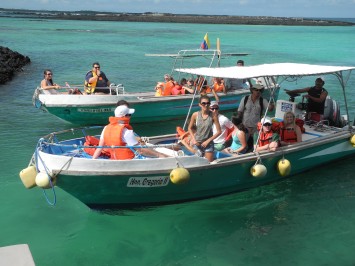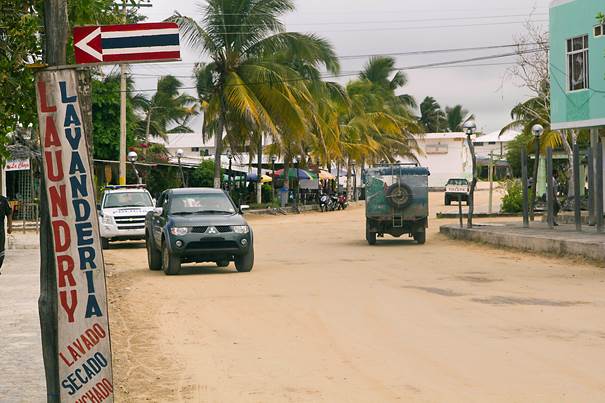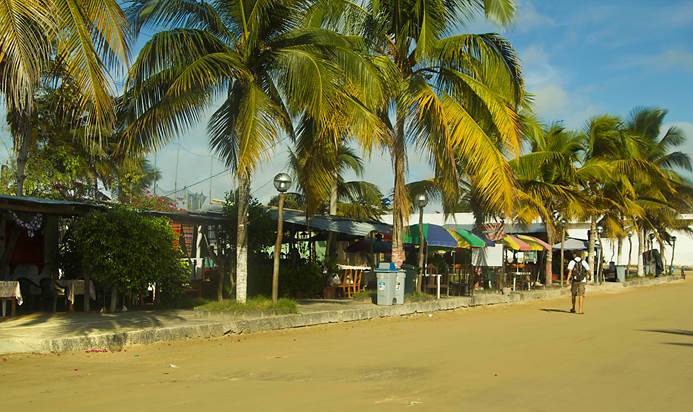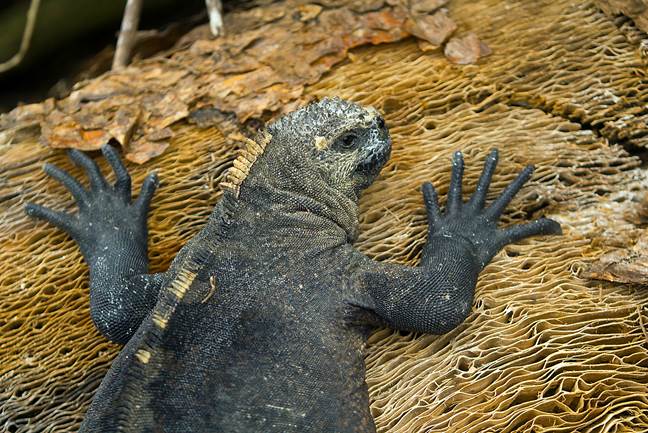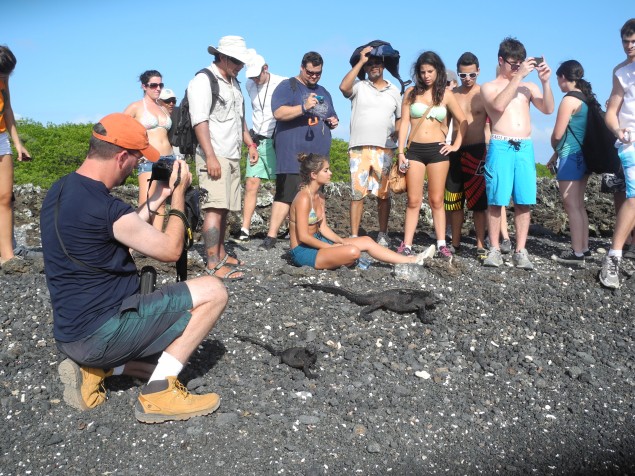PDF: TreasterJSESpring2013 [2]
Ear-Witnessing in the Galapagos Islands: The case for Experiential Learning Abroad
Joseph B. Treaster, University of Miami
Keywords: Galapagos, experiential learning, study abroad, University of Miami, The Miami Planet, acoustic ecology
We were in the Galapagos Islands and Professor Colby Leider was talking about storytelling. He’s an expert on sound. And for him, storytelling means collecting sounds with a tape recorder – the rustle of leaves, the hissing and spitting of a tortoise, footsteps on the side of a volcano, sometimes bits of conversation – and editing them into a musical narrative.
Professor Leider is a big guy – 6-foot-7-inches and 230 pounds – and he was standing there in a yellow T-shirt and blousy bush trousers, trying to inspire 17 students from the University of Miami. He is the director of music engineering at the University of Miami’s Frost School of Music. His specialty is acoustic ecology, the relationship between people and the sounds in their environment, and he has done a lot of research in the Florida Everglades.
“Sound can convey many things that other media cannot,” Professor Leider told the students.
Professor Leider, who studied music at Dartmouth College and got his PhD at Princeton University, was my partner in an experiential learning project of the University of Miami in the Galapagos Islands, a cluster of about a dozen volcanic islands in the Pacific Ocean, near the Equator, 600 miles off the coast of Ecuador. Charles Darwin did his early work on evolution in the Galapagos and the islands were now protected, at least in principle, as a World Heritage Site of the United Nations. We called our six-credit, two-week-long multi-media course, “The Galapagos Islands: Environment, Culture and the Music of Darwin.” Professor Leider was dealing with sound and the environment. I had joined the University of Miami faculty as the Knight Chair in Cross-Cultural Communication after years as a reporter and foreign correspondent for The New York Times and I had been specializing in environmental and cultural issues. I was teaching about the environment and culture of the Galapagos and about research and writing. It was all storytelling.
In the Galapagos, which have been a part of Ecuador since 1832, we had an ideal setting: raw, wild, sparsely settled islands with plants and animals found nowhere else. About 30,000 people live in the islands, drawn mostly from mainland Ecuador by dreams of earning a better living. They work as fishermen and farmers and, more and more, as tenders of the increasing waves of eco tourists. What we had here was an environmental and cultural laboratory.
Professor Leider talked about capturing sounds that conveyed a sense of place. He had been inspired by Ansel Adams, the renowned landscape photographer. “Ansel Adams captured a sense of place with photography,” Professor Leider said. “You can do that with sound.”
And, of course, you can do it with words, we told the students. And then we showed them how to do it.
We designed our program to give students a chance to embrace the Galapagos and to let the Galapagos embrace them, to sharpen their critical thinking and their ability to see things, to make them better writers and researchers and to introduce them to storytelling with words and pictures and recorded sounds. The students carried spiral notebooks as writer’s journals and little black H2n Zoom recorders with highly sensitive, built-in microphones. They wrote at least 500 words a day in their journals on what they saw and heard and felt. They took down facts and comments and scribbled out the beginnings of stories. They learned to edit their recordings and to shape them into music. Professor Leider showed them how to listen better, how to become an “ear witness.”
“An ear witness,” he told them, “can perceive aspects of the environment that a purely eye witness cannot.”
We used The Miami Planet, the University of Miami’s online environmental publication that I founded and edited, as the laboratory and showcase for the students’ work – writing, photography, videography and sound recordings. The students and Professor Leider edited the sounds they gathered into a one-hour music CD.
We let the Galapagos be our classroom and we let our experiences be our teachers. The learning came in field trips to lagoons and mangrove-lined beaches, on a more than 10-mile hike up a volcano, on small boats to nearby islands, in treks around the islands and at places where the people of the Galapagos gathered and worked. We swam with sea lions and penguins, edged up close to blue-footed boobies and watched giant land tortoises making their way along a grassy migratory path on one of the larger islands. The students lived in small hotels run by families and had lunch and dinner at little restaurants run by other families.
What we did in the Galapagos can be done in most of the world. The key is to get students out of their comfortable surroundings and into a new environment and culture and then put them in situations where much of the learning seems to flow naturally. I’ve used some of the same techniques and principles for a summer abroad program in Stockholm – an elegant, old world capital that could hardly be more different from the Galapagos.
There is a lot of room for growth in university courses using experiential learning, especially overseas. Most universities in the United States offer some form of summer abroad and semester-long study abroad programs with experiential learning. But most students do not participate. The overseas programs are not always effectively marketed and may seem expensive when, in fact, travel, housing and meals can cost less than a tourist trip – as in the case of our Galapagos program. Tuition for summer abroad and semester abroad courses is the same as for classes taken at home campuses in the United States. The summer programs are compact and intense and provide an overseas experience for students who can’t be away from their university for a whole semester.
The effect on our students has been enormous. “Immersing myself in a fresh, unknown environment helped me get a broader perspective on who I am and what I am about,” said Ben Tiberio, a sophomore music student. For Sarah Raccuglia, a junior in psychology from New Jersey, our Galapagos program was “the most physically active, mentally inspiring and spiritually enhancing experience I have ever had.”
On that morning in the Galapagos, Professor Leider was illustrating his talk on storytelling with slides projected from his MacBook Pro laptop onto a flimsy pull-down screen in an echo chamber of a classroom. The lecture was, “Introduction to Digital Audio and Sound Recording.”
He was up against a lot of distractions. The classroom was a little concrete-block building behind the Isabela Oceanographic Institute, our headquarters in the Galapagos. It was all hard surfaces: stucco walls, long, Formica-topped tables, tiled floors. Students sat at the tables in straight-backed chairs and when they shifted their bodies the steel legs of their chairs screeched on the hard floor.
Outside the big screened windows, palm fronds and flowering tropical shrubs fluttered in a light breeze. We were in the town of Puerto Villamil on Isabela Island, the largest of the Galapagos Islands. About 3,000 people live in Puerto Villamil. The air was cool, inviting, not even close to the baking heat you might expect at the Equator. The chill of the Pacific’s Humboldt or Peru Current air conditioned the islands.
A few hundred yards from Professor Leider’s classroom, the ocean was pushing the foaming, tail-ends of broken waves across a sandy beach. Crumpled heaps of black, centuries-old and hard volcanic lava rose in low, ink splotch patches on the beach. On most mornings, colonies of prehistoric-looking marine iguanas camped on the coarse rock, taking the warmth of the sun. They were black with white flecks and the rocks were black with white flecks. Perfect camouflage. Black frigate birds and brown pelicans skimmed low, searching the translucent sea for their next snack.
Paradise was just outside the classroom. And that was one of our first lessons as faculty. If we were going to connect with the students and get the most out of the Galapagos, we were going to have to get out of that concrete box. We’d been thinking along those lines as we planned the course and we could see immediately that we had been right.
The first year in the Galapagos, 2011, I worked alone. And I saw immediately that the program would be more effective with more faculty. In 2012, I was joined by Professor Leider and two other professors, Dr. Kristine Burns, an acoustic ecology specialist formerly at Florida International University in Miami, and Professor Yves Colon, a professor of reporting and writing at the University of Miami who had years of experience as a reporter and foreign correspondent at the Miami Herald. Professor Leider and Professor Burns were husband and wife and they brought their children, Liam, 10, and Livya, 7. The children went everywhere with us. Those of us who were a little older learned from watching them learn.
My original courses on researching and writing about the environment and culture morphed into a multi-media collaboration between the School of Communication and the School of Music – a first for both schools. The team approach provided an experience that was available nowhere else. We attracted students from both the School of Communication and the School of Music and from disciplines across the entire university.
I got started in experiential learning because the University of Miami wanted to develop a program in the Galapagos. I had worked throughout Latin America and had experience in the Galapagos and I was invited to be one of the start-up professors. Johann Besserer, a German-born graduate of the University of Miami, had established the Isabela Oceanic Institute and he worked closely with the university.
It seemed obvious to me that the Galapagos had a lot to teach us all. I decided in planning my first classes that our method would be hands-on, total immersion. I was an experienced journalist and a beginning academic. It was only after I had taught my first classes in the Galapagos that I discovered my approach was known as experiential teaching. Of course I was following in the steps of John Dewey and generations of others who had demonstrated that some of the most powerful learning comes from doing.
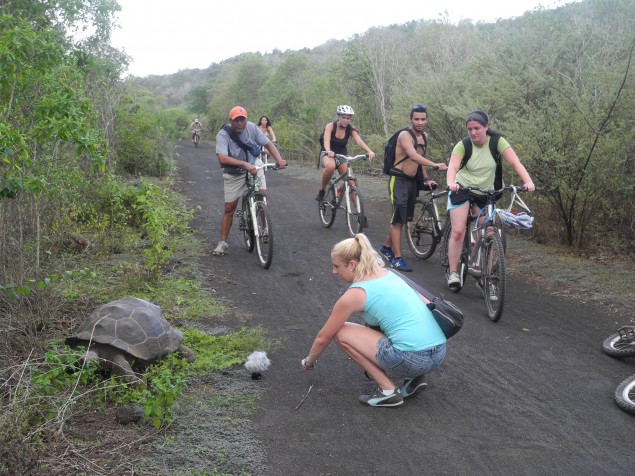 [6]
[6]University of Miami students on a bicycle field trip stop to record the sounds of a young giant Galapagos land tortoise
All of us read Darwin’s “Origin of the Species” and his journal entries on the Galapagos in the “Voyage of the Beagle,” his memoir of the five-year-long voyage that took him from England through the Galapagos and around the world beginning in 1831. Those readings primed us for what we would find. Then we used our eyes and ears. We listened to Galapagos National Park Rangers, who earn their rank and pay according to their knowledge of the flora and fauna and to their language skills, and to the fishermen, school teachers and health clinic attendants, shop keepers and the clerks and managers and elected officials of the small municipal governments who have made their homes in the Galapagos. We looked and talked and I was often able to add perspective. Some nights, we would go back to the Isabela Oceanographic Institute’s little library and fill in the details with readings from works by scientists and researchers who had devoted themselves to studying the Galapagos.
Our students adapted without much fuss to circumstances that, for most of them, were far from anything they’d ever seen. They worked on their writing and on the business of interviewing and Professor Leider gave them drills with their tape recorders and asked them to capture sounds as they moved around the Galapagos.
On the island of Isabela, where we spent most of our time, the faculty stayed in unadorned rooms above the offices of the oceanographic institute. There was a breezy terrace with a view of the sea outside the rooms on the second floor and bulky armchairs and we often worked there with the students in the cool evenings. A lot of it was one-on-one. We’d spend an hour, two hours maybe, strategizing on interviewing or squeezing the flab and the imprecision out of their writing. Professor Leider and Professor Burns had set up a sound laboratory on the ground floor of the institute and students would drop in at almost any time.
At first, we envisioned the collaboration as a seamless sharing of teaching and raw experiences. We gave separate lectures and had separate editing sessions with the students, but we emphasized that storytelling was the overarching theme and that our goal was to combine sound and the written word to create stories that would be stronger than those with only words or only sounds. We were all in this together, we told the students.
But the students didn’t believe us. They saw our program as separate pieces rather than a program of two parts. To show that we really were working together with a single objective, Professor Leider and I decided to give our lectures together as a team. And we combined all our other work. The writing faculty would edit Professor Leider’s writing assignments as well as our own and we would work together in publishing the students’ work on The Miami Planet and on the production of the one-hour music CD.
Originally students got their introduction to acoustic ecology and our research and writing assignments when we arrived in the Galapagos. Now the students start practicing with their tape recorders and do their first Galapagos research and interviews before they leave Miami.
In the first summer, we used photos of the writers to illustrate their work on The Miami Planet. Now we will be publishing the students’ writing with photos and videos that they’ve made. Inserting audio links into The Miami Planet articles is another innovation. The idea is to provide a full multi-media experience for the students and The Planet’s global audience.
We have added several days of service learning to our curriculum. Students pick places to work in Puerto Villamil. One workplace is the town’s health clinic. We plan to help out at the municipal offices, in the schools, at a water treatment center and perhaps at a tortoise-breeding center.
From the beginning, we asked our students to write a reflective essay on their time in the Galapagos. We think, as other researchers have found, that reflection has significantly deepened our students’ experiential learning and we’re expanding this writing and discussion.
The students produced great work. Michael Whitney, a junior in the School of Education, wrote a profile of a man who had abandoned a good job tasting shrimp for an export company to become an English teacher for children who had grown up speaking Spanish. Maxwell Gailey, a freshman music student, wrote about two researchers at the University of Miami’s marine science school who were surveying the mangroves of the Galapagos in connection with climate change. Lindsay Walker, a sophomore in marine affairs interviewed a 93-year-old former inmate to tell the story of a penal colony that Ecuador ran in the Galapagos until 1959. Corinne Nobili, a junior in advertising and theater, wrote about a woman who had moved from the mainland and opened a beauty parlor. Many of the students were writing articles for the first time and none of them had experience with recording sound.
They came away from the Galapagos with considerable understanding of one of the world’s environmental treasures and of life in a developing country and with new skills in gathering information, more confidence in their writing and a new awareness of sound and how it affects us and our environment. Natalie Pena, a senior in broadcasting and creative writing, said she had gotten “a new, better tuned set of ears.”
Christian Suglia, a freshman in psychology and electronic media, said “the accelerated classes forced me to improve my writing very fast.” He said he was independent before the trip, but that studying in the Galapagos made him more independent. “I got a semester’s worth of education in two weeks,” he said, “had the time of my life and made some really good friends.”
The students were mostly urban, well-off young people. The journey to the Galapagos showed them a simpler way of living. “You realize how much excess people in the United States have,” said Megan Dettmer, a freshman in public relations from near Trenton, N.J. She said the work with sound reinforced her interest in theater production, but that the desperately beautiful beaches of the Galapagos had made her wonder if she really wanted to stick with her plan to move to Seattle after college.
Gailey, one of the music students and the son of a professor in the School of Medicine, said he “picked up on the idiosyncrasies – the pace of life, the way people interact – things that couldn’t be picked up from reading a book.
Melissa Gemore, a junior in sociology from New Jersey, said she learned a lot about the people and the wildlife of the Galapagos and discovered a culture that was “much different from what I am used to.” She found the big tortoises, marine iguanas, sea lions, penguins and flamingos “oddly tame” and was surprised that she was able to get close enough to almost touch them. Somehow, she said, she immediately felt like a part of the family she stayed with. Her writing improved and she began listening in a different way. She had gotten just what experiential learning had intended to give her. “Even though this was a school trip,” she said, “it didn’t feel like it.”
You can see our students’ work in The Miami Planet’s Galapagos Diary at http://www.themiamiplanet.org/category/diaries/galapagos-diary/
